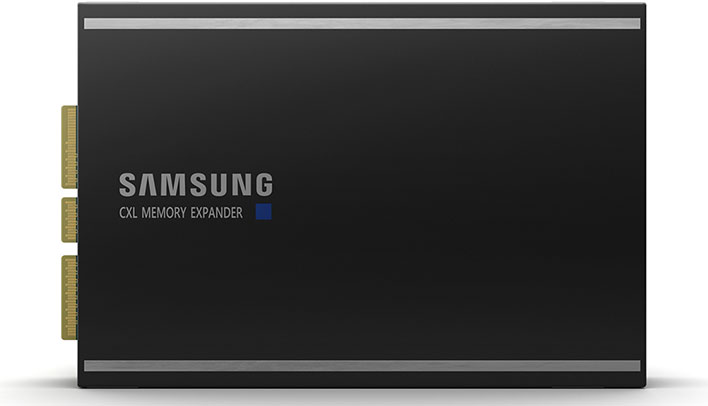Samsung Backs Innovative CXL PCIe 5 Memory Module With An Open Source AI Dev Kit
Back in May, Samsung unveiled a high-tech gadget for data centers called the CXL Memory Expander, essentially a memory expansion device that utilizes the newer Compute Express Link interconnect standard. As with most hardware, however, the clever device is only as good as the software. To address that fact, Samsung has now introduced what it says is the industry's first open-source software solution that is specifically designed to support the CXL memory platform.
The upshot of Samsung's CXL memory expander is it allows clients to scale memory capacities and bandwidth in data centers to terabyte levels, going well beyond what was previously possible. CXL itself is an open, industry-supported interconnect based on the high-speed PCI Express 5.0 bus. It is also based on DDR5 RAM and gets recognized as main memory by both the CPU and GPU.
Now with the introduction of Samsung's open-source, Scalable Memory Development Kit (SMDK), the company is extending a hand beyond the hardware in hopes that its CXL platform will ultimately be more accessible to data center developers.
The upshot of Samsung's CXL memory expander is it allows clients to scale memory capacities and bandwidth in data centers to terabyte levels, going well beyond what was previously possible. CXL itself is an open, industry-supported interconnect based on the high-speed PCI Express 5.0 bus. It is also based on DDR5 RAM and gets recognized as main memory by both the CPU and GPU.
Now with the introduction of Samsung's open-source, Scalable Memory Development Kit (SMDK), the company is extending a hand beyond the hardware in hopes that its CXL platform will ultimately be more accessible to data center developers.
"In order for data center and enterprise systems to smoothly run next-generation memory solutions like CXL, development of corresponding software is a necessity," said Cheolmin Park, vice president of the Memory Product Planning Team at Samsung Electronics. "Today, Samsung is reinforcing its commitment toward delivering a total memory solution that encompasses hardware and software, so that IT OEMs can incorporate new technologies into their systems much more effectively."
What this means for developers and clients is that they can get actual main memory and the CXL memory expander to play nice together in advanced IT systems, and without having to modify existing application environments, Samsung says.
The open-source software kit comprises various libraries (pre-built and reusable codes) and application programming interfaces (APIs). It also supports memory virtualization, to enable system designers to better manage expanded memory pools in shared memory architectures.
As we pointed out earlier this year, none of this applies to home consumers, at least not directly. But data center technologies have a way of eventually trickling into the consumer space. We're seeing this already, with error-correcting code (ECC) becoming a standard feature of DDR5 memory, which is about to enter the mainstream with the arrival of Intel's Alder Lake launch. So perhaps the days of measuring system RAM in terabytes instead of gigabytes isn't all that far off (hey, we can dream!).
For now, this is all reserved for the data center. Samsung is making its SMDK available on a limited basis while it works out the kinks and optimizes the architecture. Then the plan is to make it available to all in the first half of next year.


